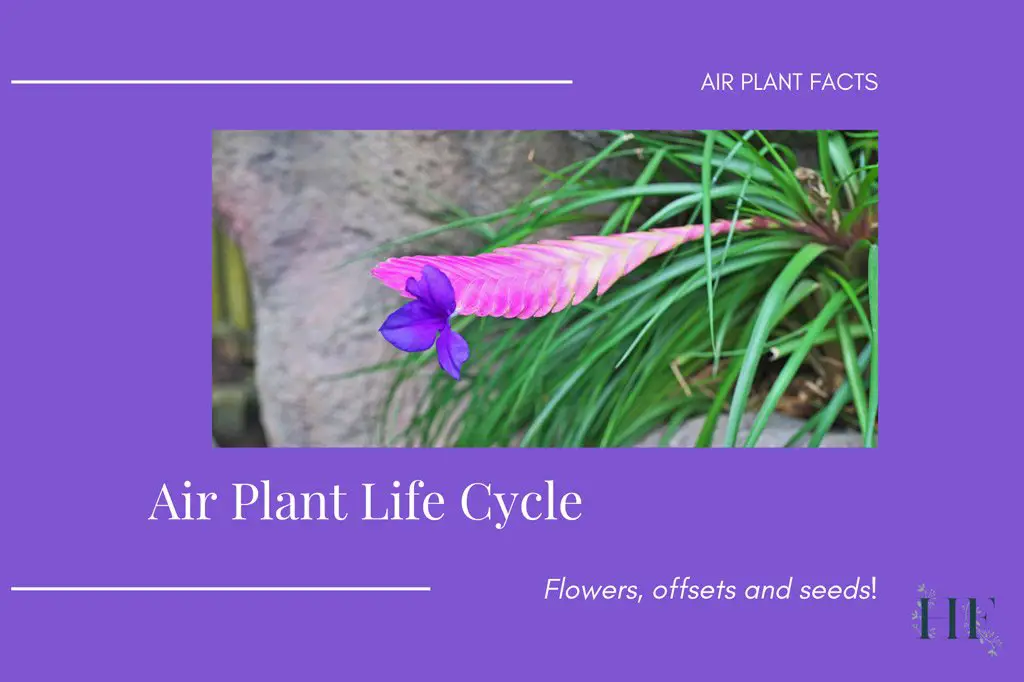Since I discovered that air plants are not common houseplants, I started to wonder… what is the life cycle of an air plant? Also, do air plants flower?
Air plants’ life cycle has three stages: flower, offsets (or pups) and seeds. When air plants reproduce, they will bloom once and produce offsets. If an air plant is pollinated, it will also produce seeds.
In this blog post, I will explain air plants’ growth cycle, how they reproduce and how much they can grow.

Air Plant Reproduction
Knowing how your air plants reproduce will help you take better care of them and avoid disappointments.
Tillandsias, aka air plants, can reproduce in two ways:
- Sexual reproduction.
- Asexual reproduction.
But it’s not that simple! I had to revisit my biology notes since these tropical plants have diverse flowering patterns, pollination modes and breeding systems (source).
Air Plant Sexual Reproduction
Tillandsias create seeds when their flowers are pollinated.
Now is when it gets tricky…
Tillandsia spp. can be:
- Self-compatible: They self-pollinate, which is when there’s a transfer of pollen from the stamen of a plant to its stigma. So, they don’t need pollinators.
- Self-incompatible: They cross-pollinate, which occurs when the pollen from a male part of a plant is transferred to a female part of a plant, later enabling fertilisation and the production of seeds. In the case of hermaphroditic air plants like T. streptophylla, studies show their need for pollinators.
In the wild, an air plant’s foliage changes colour when it blooms. Also, they have evolved floral characteristics that attract a wide variety of pollinators.
All these bright colours and features attract pollinators like insects (moths and bees), birds (like hummingbirds), and even bats!
Depending on the Tillandsia species, the pollinators that they attract vary. For instance, T. duratii attracts bees and moths, but T. recurvifolia attracts butterflies and hummingbirds (source).
Don’t forget that the wind can also act as a pollinator. 😉
Finally, cross-pollination between species (natural hybridization) seems to be responsible for some portion of the variations in the Tillandsia species (650 plus varieties).
However, it has allowed botanists to create Tillandsia hybrids. For example:
- T. Redy is a hybrid of T. Streptophylla and T. Concolor developed by Mark Dimmitt.
- T. John Arden’s Art is a hybrid of T. intermedia and T. capitata marron developed by John Arden.
Air Plant Asexual Reproduction
Air plants create offsets (also known as pups). I will expand on this further down (refer to the Offsets or Pups section below).
But, for any of these types of reproductions to occur, first Tillandsias need to flower. 🙂
Air Plant Life Cycle
There are 3 stages to an air plant’s growth cycle. The first stage is the beginning of the reproductive process when the inflorescence (a flower stalk) appears.
Here are the 3 stages:
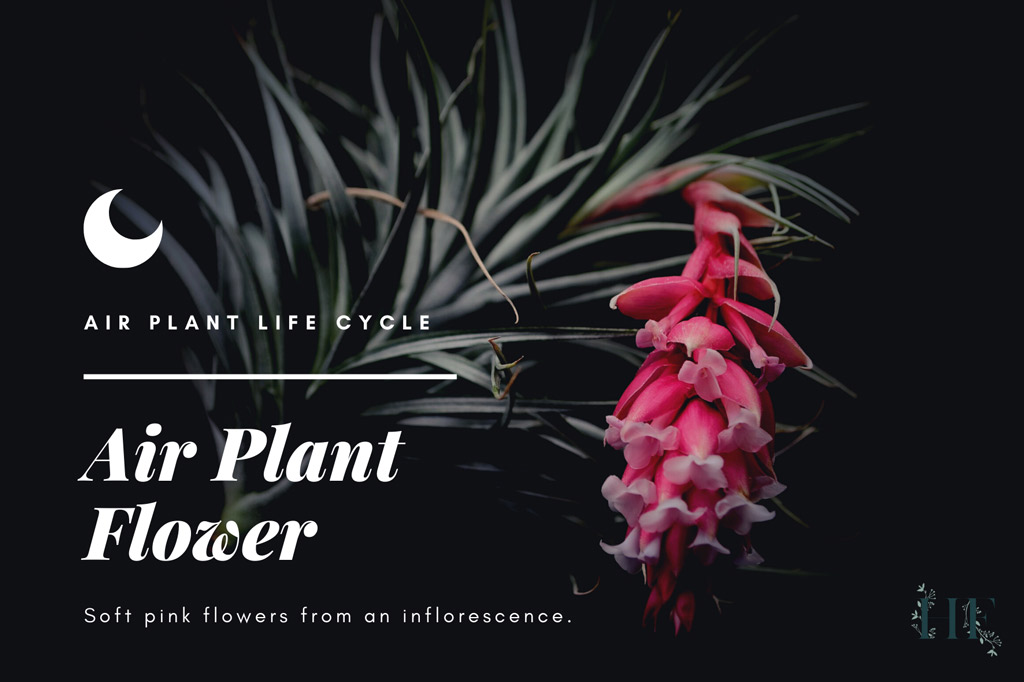
1) Flower
The Tillandsia genus is an excellent example of diversity because these tropical plants exhibit a multitude of physiological and morphological differences: shape, texture, colour, flowers, size, etc.
Before they flower, the leaves towards the top of the plant start turning red or pink. Depending on the type, an air plan blooms as a single bloom or a cluster.
The blooms are arranged on a stem that is composed of one main branch or multiple branches, also known as inflorescence. I.e., the flowers will emerge from the inflorescence. Some inflorescences are soft and round while others can be sharp and spiky.
The flowers have bright, vibrant colours that can vary greatly:
- Red.
- Yellow.
- Purple.
- Pink.
- Multicolour.
Some flowers are very long-lasting such as the flowers of T. xerographica, which can last up to a year-long.
For other air plants, however, their blooms will only last from a couple of days to some weeks.
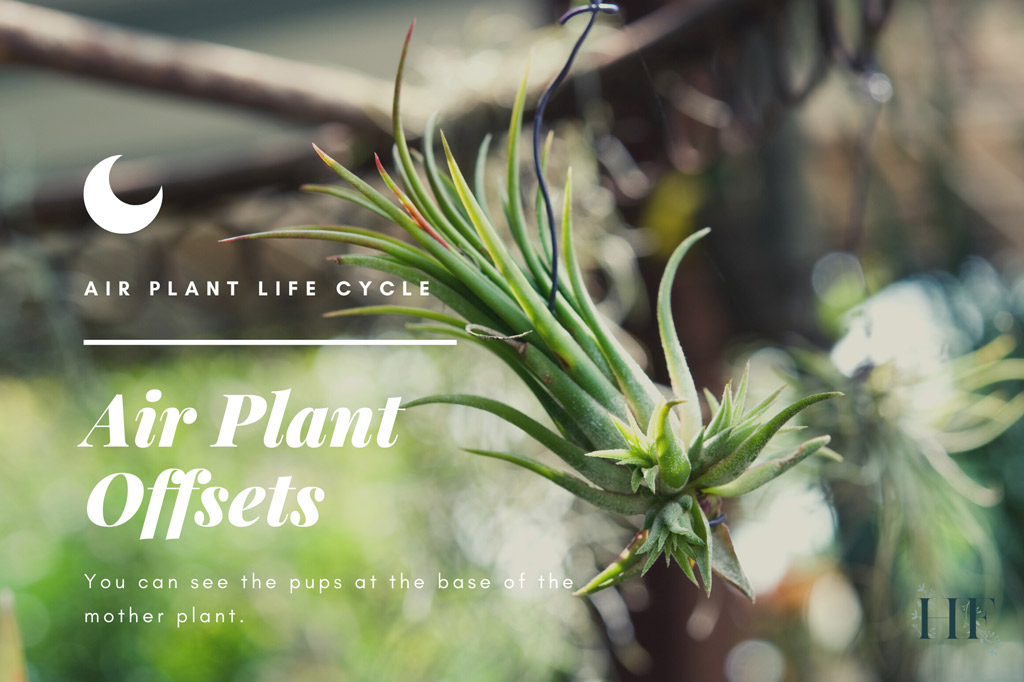
2) Offsets or Pups
After flowering, the next stage of their life cycle starts when an air plant starts producing offsets.
When air plants follow an asexual reproduction, they create their offsets, also known as pups. These are miniature versions of the parent plant.
But, when do air plants reproduce?
Depending on the species, an air plant will reproduce (using an asexual reproduction method) before, during or after flowering, producing offsets as a result.
You don’t have to worry about pollinating your air plants as they don’t need it to grow pups.
Again, depending on the type of air plant, they will produce 1 to 3 pups on average.
Usually, these little offsets can be found at the base of the plant (you are likely to notice “new growth” at the sides). But they can also be found protected under dying leaves (so use caution when pruning your air plant). In some varieties, pups can emerge out of the flower stalk instead.
What about the mother plant?
The mother air plant will then continue to support the growth of its pups until it exhausts itself completely. This plant will be putting all its energy into growing its pups (survival instinct).
This process can take up to several years, depending on the species of an air plant. That’s why an air plant doesn’t die immediately after flowering, but it will eventually fade away and leave you some wonderful pups to look after!
Pups can show good growth and get larger within a few months. There are two options when it comes to the offsets:
- Separate them from the mother: Once the offsets reach about 1/3 the size of the adult plant, you can snip them off. Remove them carefully using a sharp pair of scissors
- Let them form a clump or cluster: If you leave them connected, they will continue to grow even after the mother plant dies. They will form an air plant cluster or clump, basically, a group of air plants arranged in a circular shape. This formation is also known as “tillandsia balls.”
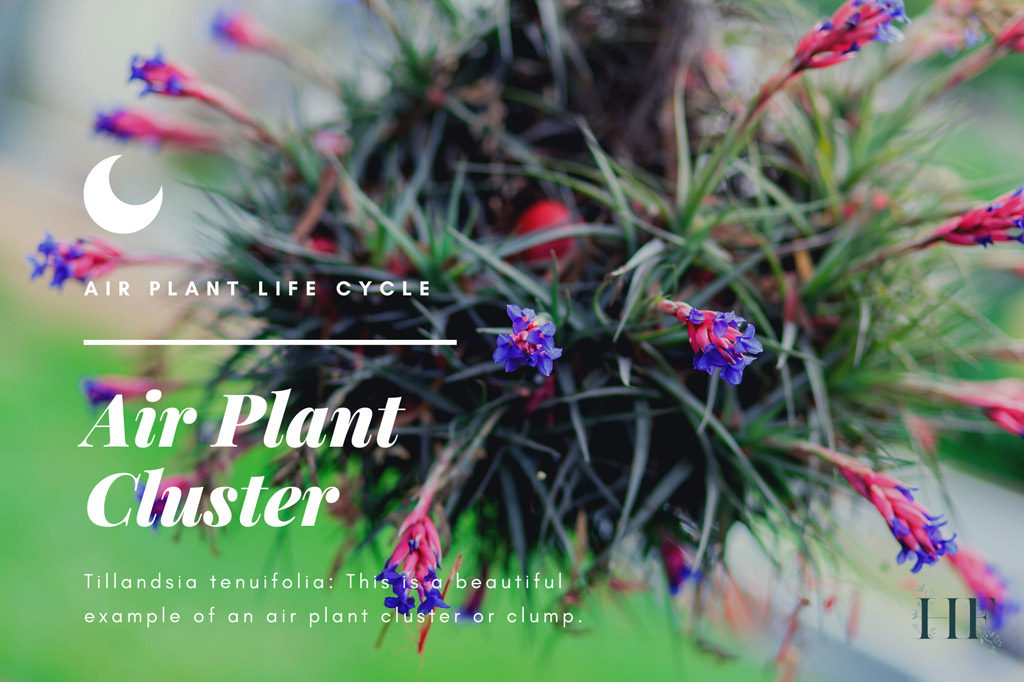
These pups will mature into adult air plants and repeat the growth cycle.
Read also: Air Plant Propagation Guide and Pup Care.
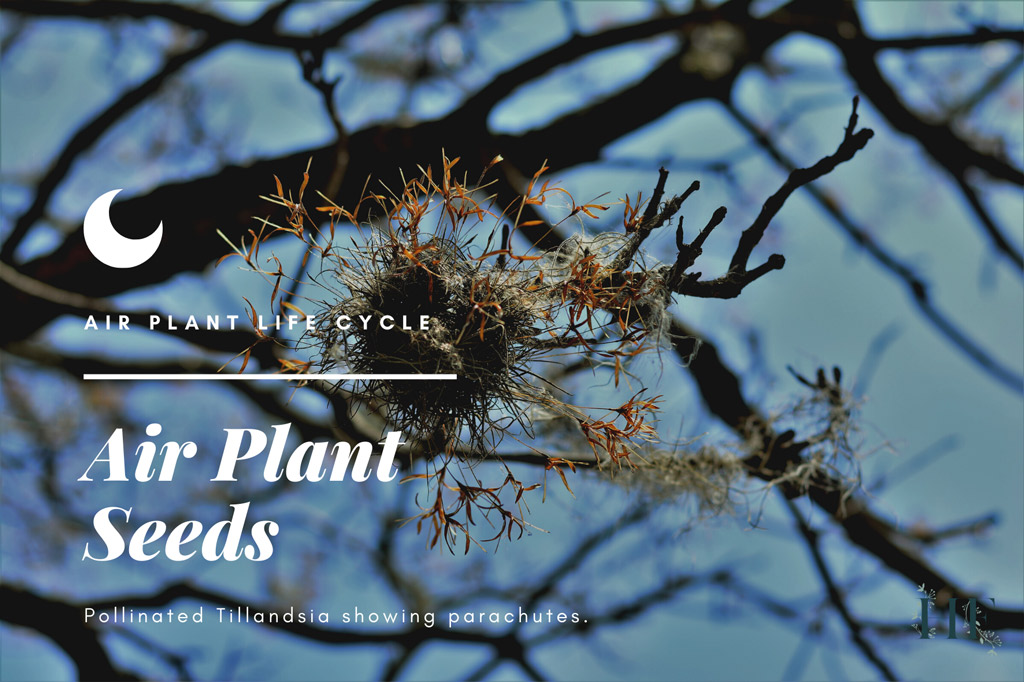
3) Seeds
After blooming, the cycle of life for the air plants continues.
Apart from producing offsets, air plants can also produce seeds. The flowers of an air plant need to be pollinated so they can form seed pods. Otherwise, it will only grow pups.
In their native habitat, this process usually occurs during the dry season (so the rain doesn’t wash them off). And then when the rainy season begins, the seeds are ready to germinate and grow into air plants.
How do you know if your air plants got pollinated?
Have a look and see if seed pods have been formed in place of the flowers after blooming.
But, they can take between three months to about two years to develop! When it’s time, the walls of the pod will split and release the seeds as a result.
These seed pods contain Tillandsia seeds encased in fluffy hairs that are known as parachutes. This structure makes it easy for them to travel through the air and their hairs help them to attach to a new surface (just like dandelion seeds).
In the wild, these parachutes will attach themselves to new plants, trees or rocks and start germinating in their new location.
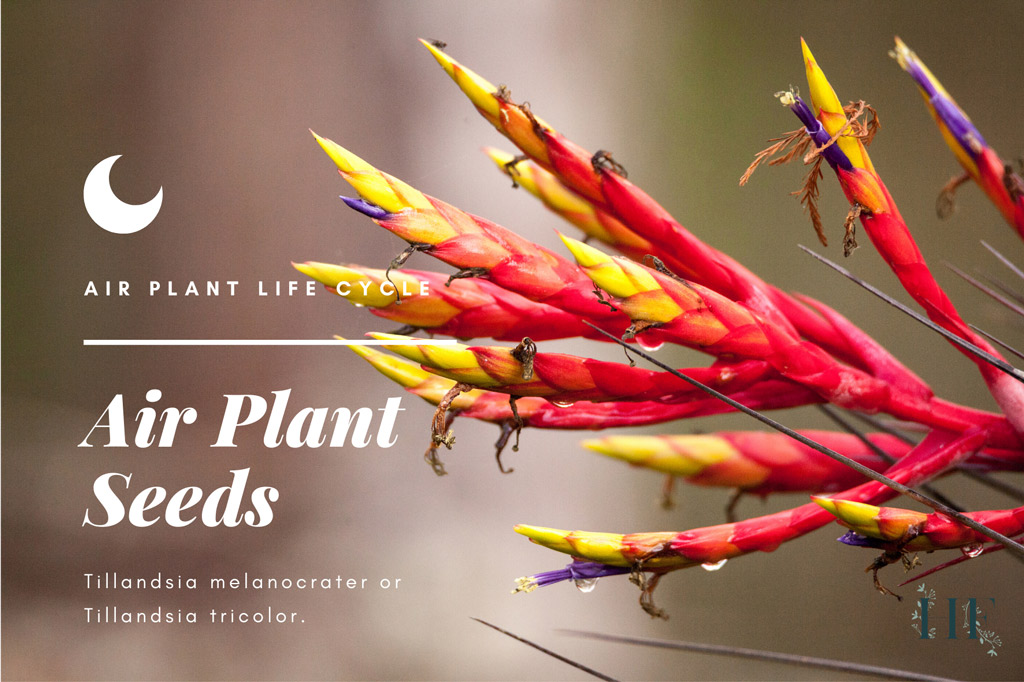
Can you grow air plants from seeds?
Of course! But it requires lots of patience. 😉
Growing air plants from seeds is a long process, but also a very rewarding one too. It takes years to grow air plants from seed.
There are advantages to growing your houseplants from seed though! When you grow a plant from seed, you can tether it to your environment (location, temperature, light, humidity…).
This will make your houseplant:
- Stronger: It has grown to thrive in your exact environment.
- Healthier: You reduce the chance of bringing home any pests or diseased plants since you grow them yourself. Sometimes, it’s unavoidable to bring home a plant that has spider mites, for instance, even when bought from a reputable shop.
Up till now, I haven’t attempted to grow any houseplants from seeds yet (I definitely want to give it a go though). I’m otherwise practising propagating some of my plants via division or cuttings.
However, please let me know in the comments below if you have grown air plants from seeds, I would love to know more about it!
As far as I know, the seed must be kept damp, but not too damp as to encourage fungus (a tricky balance).
The germination process takes about a month and the first few years of growth are very slow. When the air plant reaches about an inch in length, the growth rate increases. Yey!
Check how to grow air plants from seeds here.
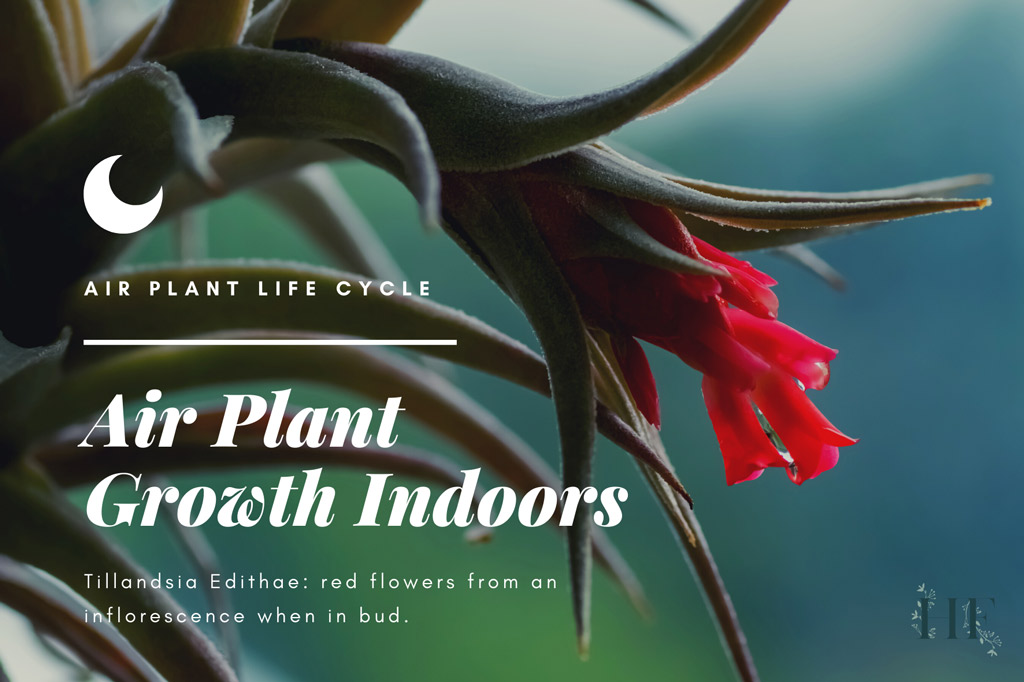
Air Plant Growth
I want to finish by addressing air plants’ growth rate.
How Fast Do Air Plants Grow?
As I just mentioned, seedlings will grow much slower. For the first few years, air plants’ size will be under 1 inch.
After reaching that 1 inch, their growth rate will increase considerably.
In general, air plants are slow-growing plants. One of the advantages is that they will not outgrow their display for a long time! 🙂
Read also: Air Plant Care – 8 Steps to Grow and Keep Tillandsias Alive.
Do Air Plants Grow Bigger?
How big an air plant gets depends on three things:
- The Tillandsia species you have.
- The environmental conditions where you grow it.
- The care you give to your air plant.
If you want a big air plant, you could choose a variety that gets big, like:
- T. xerographica: It can grow over 36 inches (91.4cm) in size, including its large orange bloom spike.
- T. usneoides (Spanish Moss): This air plant can also vary in size. On average they can get between 12 to 30 inches tall (20.5-76 cm). In their natural habitat, they can form hanging structures up to 240 inches (6.1 m) in length.
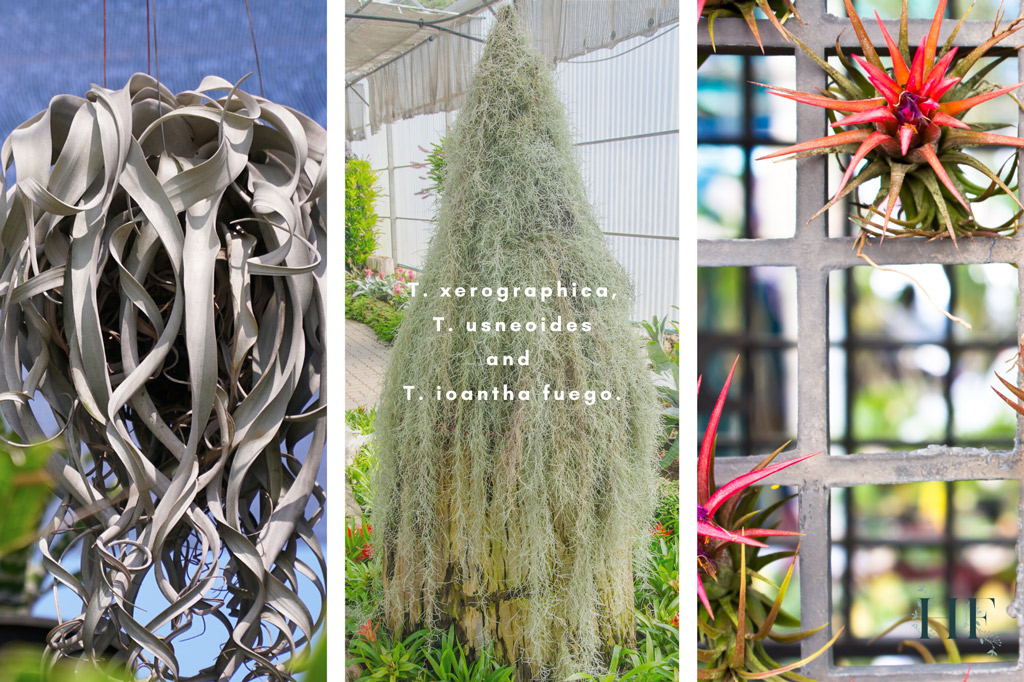
Smaller air plants include:
| AIR PLANT | SIZE |
|---|---|
| T. ioantha | It usually reaches 8 to 12 cm in height (3-5 inches). |
| T. butzii | It’s 18 to 23 cm tall (7-9 inches). |
| T. bulbosa | It can be 25 to 30 cm in length (10-12 inches). |
| T. fuchsii | It’s about 5 to 8 cm in height (2-3 inches). |
But, smaller size sir plants can become large when grown in clumps or clusters.

I hope you enjoyed these wonderful examples of air plants! Got any questions or a Tillandsia story to tell? Let me know in the comments below!

